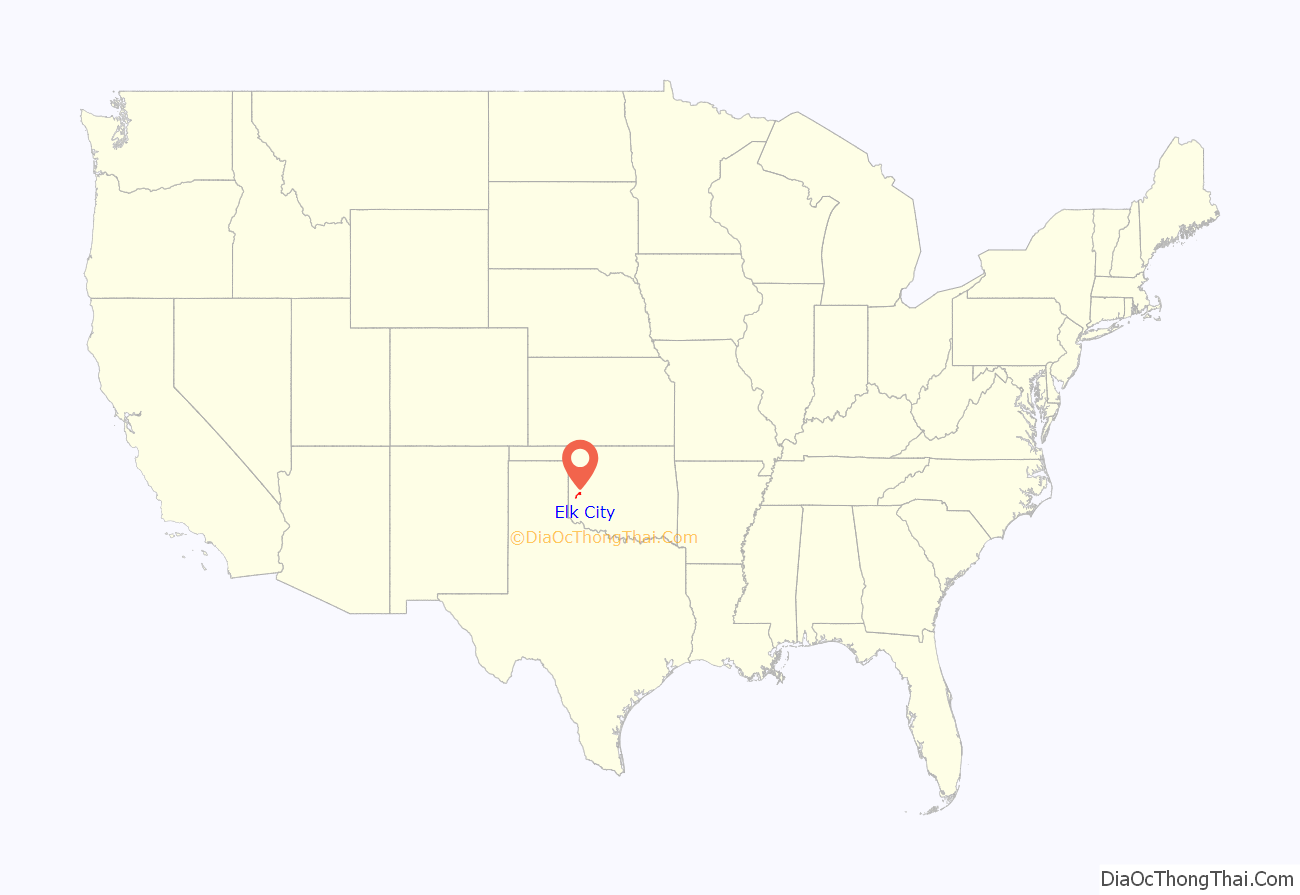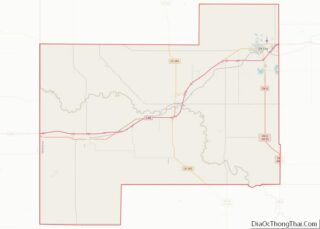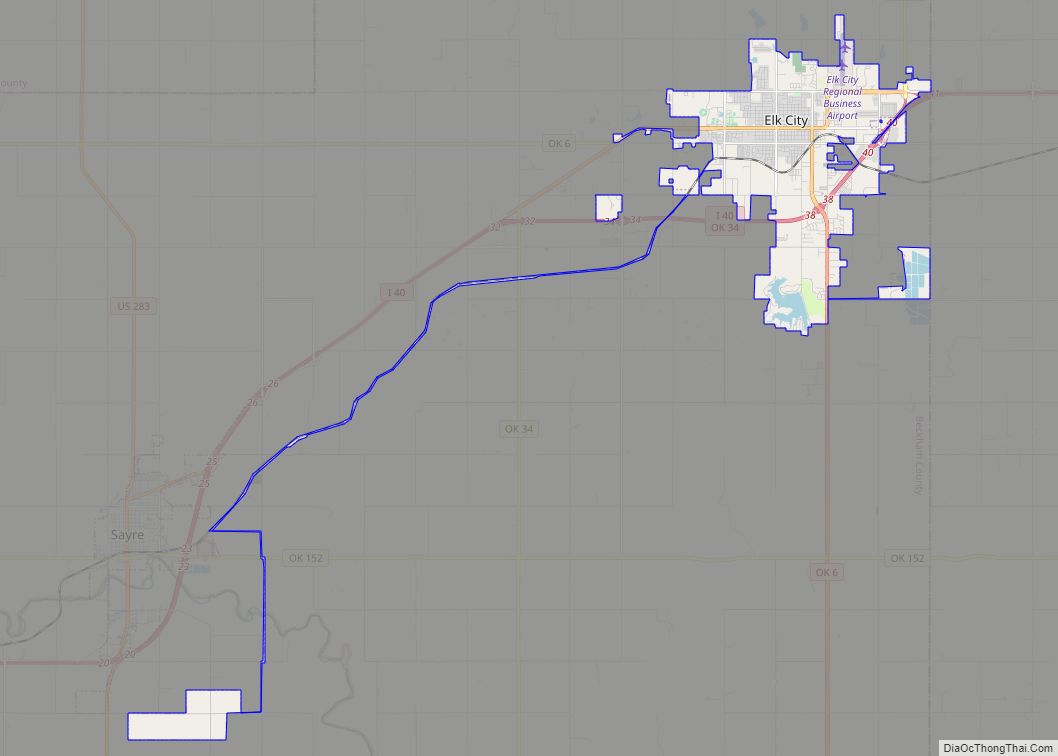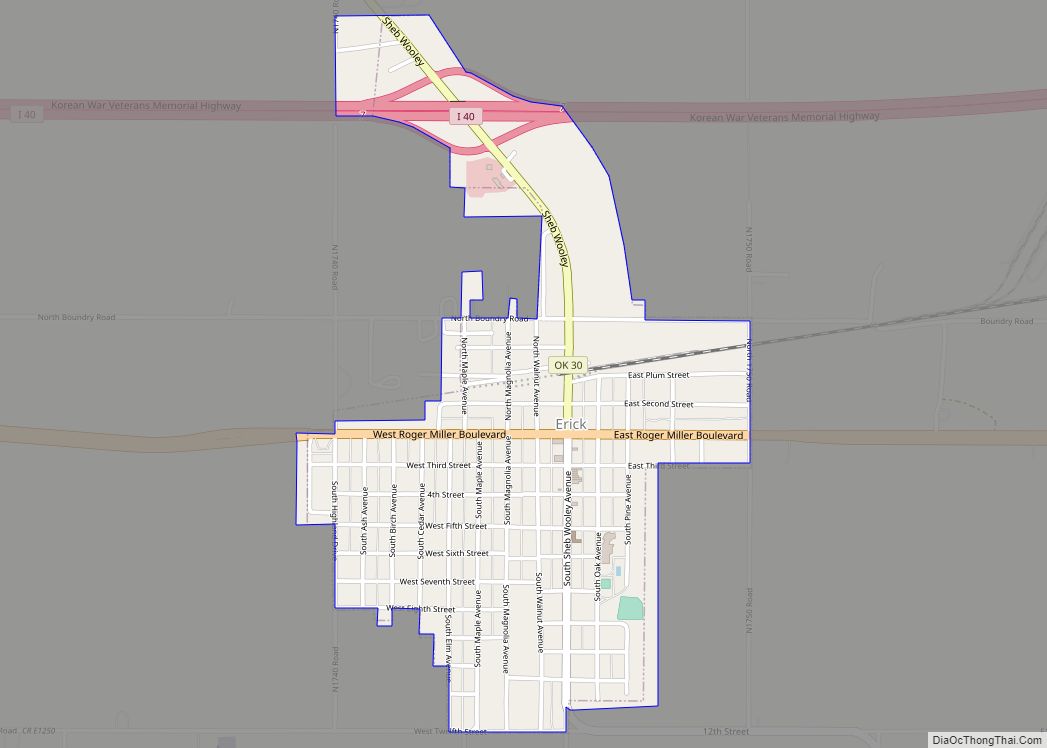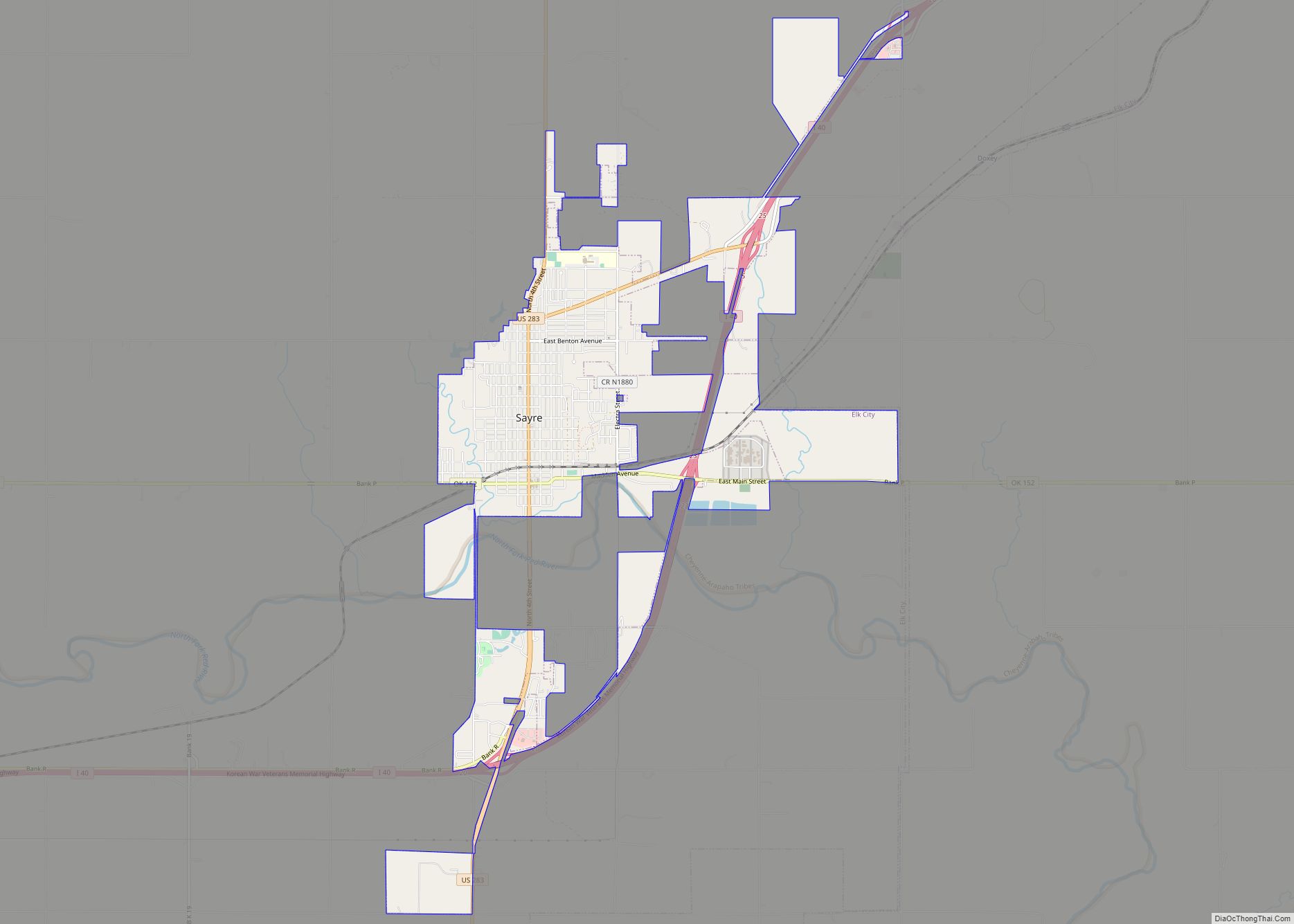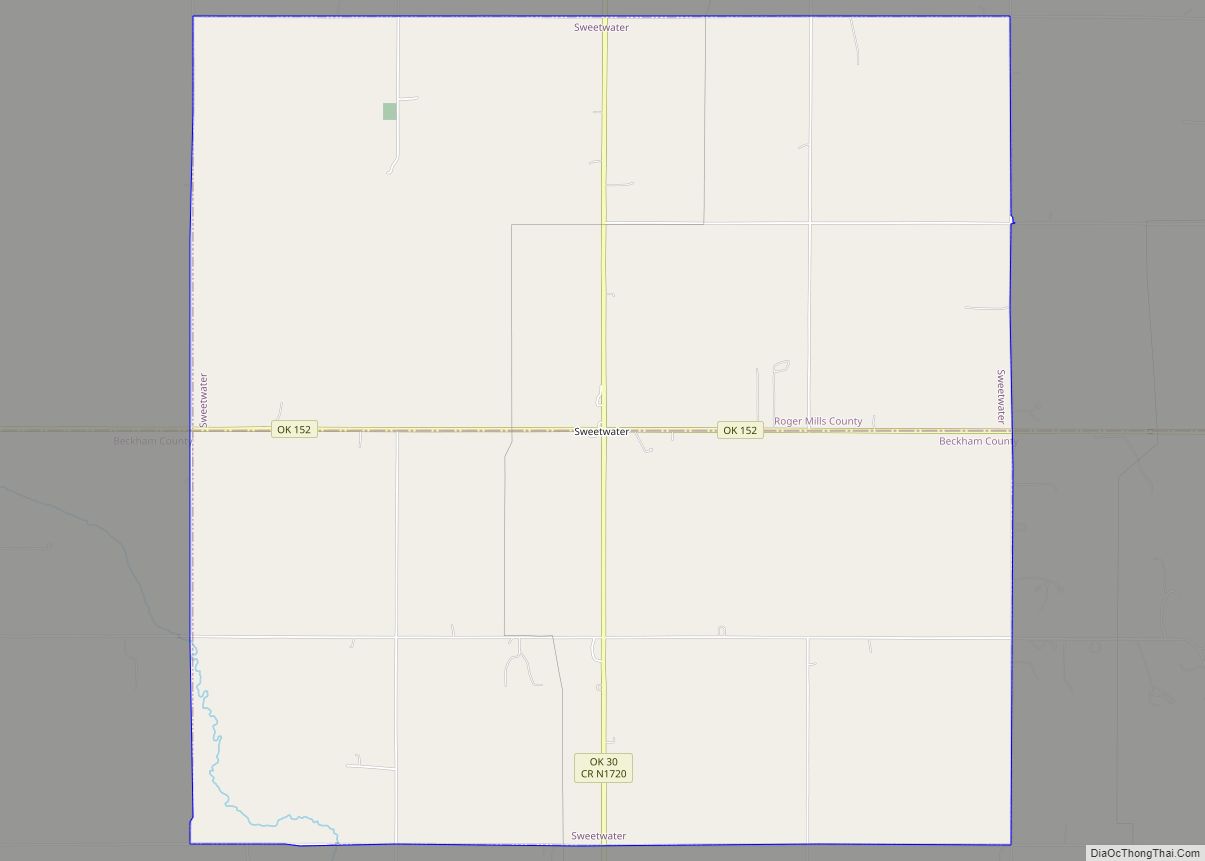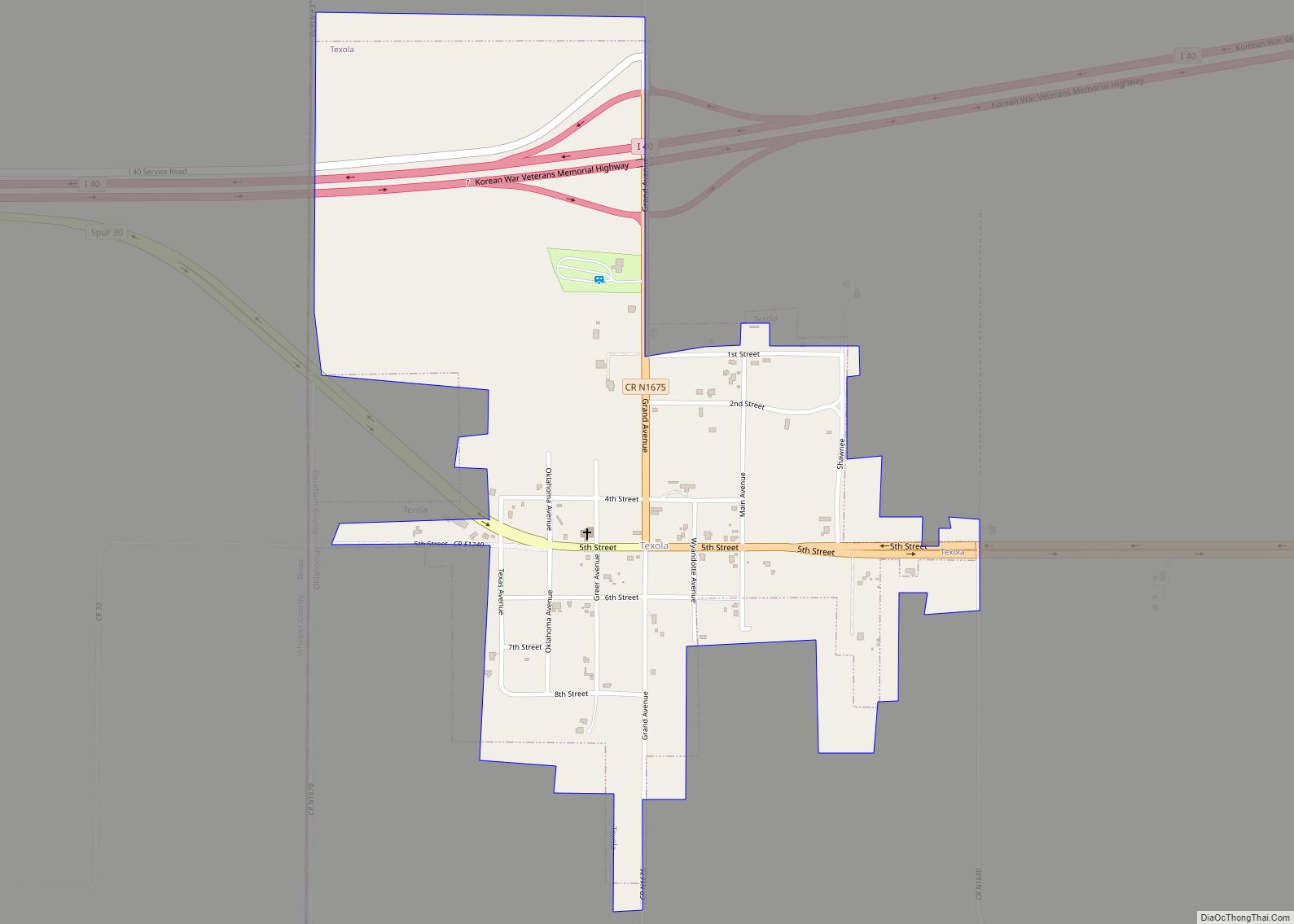Elk City is a city in Beckham County, Oklahoma, United States. The population was 11,693 at the 2010 census, and the population was estimated at 11,577 in 2019. Elk City is located on Interstate 40 and Historic U.S. Route 66 in western Oklahoma, approximately 110 miles (180 km) west of Oklahoma City and 150 miles (240 km) east of Amarillo, Texas.
| Name: | Elk City city |
|---|---|
| LSAD Code: | 25 |
| LSAD Description: | city (suffix) |
| State: | Oklahoma |
| County: | Beckham County |
| Founded: | 1901 |
| Elevation: | 1,919 ft (585 m) |
| Total Area: | 16.15 sq mi (41.84 km²) |
| Land Area: | 15.93 sq mi (41.26 km²) |
| Water Area: | 0.22 sq mi (0.58 km²) |
| Total Population: | 11,561 |
| Population Density: | 725.78/sq mi (280.22/km²) |
| ZIP code: | 73644, 73648 |
| Area code: | 580 |
| FIPS code: | 4023500 |
| GNISfeature ID: | 1092527 |
| Website: | elkcity.com |
Online Interactive Map
Click on ![]() to view map in "full screen" mode.
to view map in "full screen" mode.
Elk City location map. Where is Elk City city?
History
European exploration
In 1541, Francisco Vásquez de Coronado became the first known European to pass through the area. The Spanish conquistador was traveling northeast across the prairie in search of a place called Quivira, a city said to be fabulously wealthy with gold. Because Coronado’s route across the plains is speculative, it is quite possible that the expedition passed through present-day Elk City or the nearby area.
Founding to statehood
Elk City’s history dates back to the days immediately following the opening of the Cheyenne-Arapaho reservation in western Oklahoma Territory on April 19, 1892, when the first white settlers made their appearance. Prior to this time, many early ranchers had driven cattle over the Great Western Cattle Trail from Texas to Dodge City, Kansas, the present townsite of Elk City being in the direct path of that famous trail.
The creation of Elk City was an idea conceived by land promoters from Weatherford, Oklahoma, when they learned that the Choctaw, Oklahoma and Gulf Railroad (CO & G) was coming to the area (in 1898, the CO & G Railroad completed its western route to Weatherford; beginning in 1901, it continued building west). They formed the Choctaw Townsite and Development Company. These men with great foresight determined that the area at the source of Elk Creek would be an ideal location for a town, so they came to the area to purchase lands from the homesteaders who had claims along the railroad.
Probably the most important day in Elk City’s history is March 20, 1901, the date the first lots were sold by the Choctaw Townsite and Development Company. By this time, hundreds of prospective purchasers had built a tent city. On that day, the townsite company sold $32,000 worth of property (about $870,000 in 2012 dollars) and continued doing a good business for some time thereafter.
There is some confusion about how Elk City got its name. Elk City was so named because it is located at the head of Elk Creek, which in turn was named by U.S. Army Captain Randolph B. Marcy who was leading an expedition to explore the Red River in 1852. Marcy and his troops had left the Wichita Mountains and the waterway which he named Otter Creek during his exploration, and they were traveling northwest along the North Fork of the Red River. On May 31, in the official journal of the expedition, Marcy wrote about the productive soil, the dense grass, and the vertical red clay banks of a “bold running stream of good water.” Continuing, he wrote, “From the circumstance of having seen elk tracks upon the stream we passed in our march today, I have called it ‘Elk Creek’. I am informed by our guide that five years since, elk were frequently seen in the Wichita Mountains; but now they are seldom met with in this part of the country.” Confusion also stems from the early post offices that served the residents of the town. Even though the town of Elk City has had only one name, its early settlers were served by a post office named Crowe, and later, one named Busch. Consequently, on many early maps of Oklahoma Territory the names of “Crowe” or “Busch” are seen instead of “Elk City“. Finally, on July 20, 1907, shortly before statehood, the Busch Post Office had its name officially changed to Elk City Post Office.
On August 13, 1901, the Choctaw, Oklahoma and Gulf Railroad (purchased in 1904 by the Chicago, Rock Island and Pacific Railroad in 1904) laid its last rail on the so-called “Choctaw Route”, bringing rail access to Elk City. The first regular train service commenced seven days later on August 20, and city folk rejoiced, predicting that the dugouts, claim shacks, and prairie stables would soon disappear and be replaced by handsome residences, commodious barns, and granaries.
By January 1902, Elk City had more than sixty businesses and a population exceeding 1,000. Paving the streets with bricks also began in 1902. Though not yet a year old, the town had become one of the largest in western Oklahoma. Even with two devastating fires (one on October 28, 1903, which destroyed more than a dozen businesses, and the other in March 1906 which burned sixteen businesses to the ground), Elk City continued to grow into a major transportation and commercial hub, and by statehood in 1907, the population had more than tripled to 3,000 people. The prairie community had become a boomtown.
Elk City Road Map
Elk City city Satellite Map
Geography
Elk City is located in northeastern Beckham County at 35°24′10″N 99°25′26″W / 35.40278°N 99.42389°W / 35.40278; -99.42389 (35.402694, -99.423812), elevation 1,928 feet (588 m).
According to the United States Census Bureau, the city has a total area of 16.4 square miles (42.5 km), of which 16.2 square miles (41.9 km) is land and 0.23 square miles (0.6 km), or 1.37%, is water.
Climate
According to the Köppen Climate Classification system, Elk City has a humid subtropical climate, abbreviated “Cfa” on climate maps. The hottest temperature recorded in Elk City was 114 °F (45.6 °C) on July 19, 2022, while the coldest temperature recorded was −12 °F (−24.4 °C) on January 17, 1930 and January 19, 1984.
See also
Map of Oklahoma State and its subdivision:- Adair
- Alfalfa
- Atoka
- Beaver
- Beckham
- Blaine
- Bryan
- Caddo
- Canadian
- Carter
- Cherokee
- Choctaw
- Cimarron
- Cleveland
- Coal
- Comanche
- Cotton
- Craig
- Creek
- Custer
- Delaware
- Dewey
- Ellis
- Garfield
- Garvin
- Grady
- Grant
- Greer
- Harmon
- Harper
- Haskell
- Hughes
- Jackson
- Jefferson
- Johnston
- Kay
- Kingfisher
- Kiowa
- Latimer
- Le Flore
- Lincoln
- Logan
- Love
- Major
- Marshall
- Mayes
- McClain
- McCurtain
- McIntosh
- Murray
- Muskogee
- Noble
- Nowata
- Okfuskee
- Oklahoma
- Okmulgee
- Osage
- Ottawa
- Pawnee
- Payne
- Pittsburg
- Pontotoc
- Pottawatomie
- Pushmataha
- Roger Mills
- Rogers
- Seminole
- Sequoyah
- Stephens
- Texas
- Tillman
- Tulsa
- Wagoner
- Washington
- Washita
- Woods
- Woodward
- Alabama
- Alaska
- Arizona
- Arkansas
- California
- Colorado
- Connecticut
- Delaware
- District of Columbia
- Florida
- Georgia
- Hawaii
- Idaho
- Illinois
- Indiana
- Iowa
- Kansas
- Kentucky
- Louisiana
- Maine
- Maryland
- Massachusetts
- Michigan
- Minnesota
- Mississippi
- Missouri
- Montana
- Nebraska
- Nevada
- New Hampshire
- New Jersey
- New Mexico
- New York
- North Carolina
- North Dakota
- Ohio
- Oklahoma
- Oregon
- Pennsylvania
- Rhode Island
- South Carolina
- South Dakota
- Tennessee
- Texas
- Utah
- Vermont
- Virginia
- Washington
- West Virginia
- Wisconsin
- Wyoming
